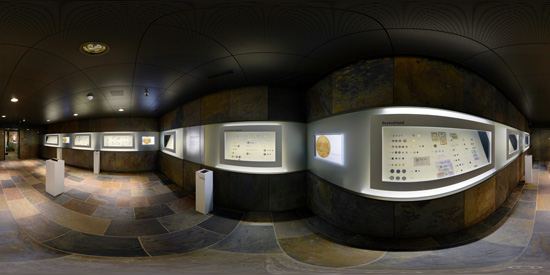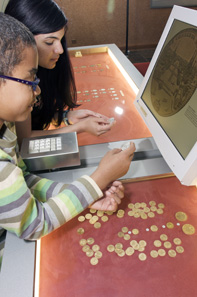by Ursula Kampmann
April 11, 2013 – PANTA RHEI – ‘everything flows.’ This quote from the work of the Greek philosopher Heraclitus perfectly encapsulates everything the Money Museum strives to be – always changing, never resting on the laurels of its past, and always remaining in the lead when it comes to the challenge of seeking out new forms of communication.
This is why the MoneyMuseum is selling a tiny but valuable portion of its collection. The proceeds will go towards financing a brand new chapter of the MoneyMuseum: a multimedia presence on iTunes University.
A debut on the Internet
It all began with 500 coins privately amassed Dr. Jürg Conzett. Leo Mildenberg oversaw the collection right until his death, which is one of the reasons for the outstanding quality of the Greek coinage, in particular.
But the owner of this collection travelled so often, he barely had a chance to hold the coins in his own hands – for Jürg Conzett, the Internet offered a solution. He put his collection on the Net at moneymuseum.com, both for himself and for anyone who might be interested in it. In April 1999 the MoneyMuseum went online, and interest did indeed prove great, since at the time, although perhaps hard to imagine today, it was the first institution to make a large volume of coin photos available on the Internet.
Treasures under earth: The gold room houses part of the coin collection of the MoneyMuseum. © MoneyMuseum, Zurich.
Today, the MoneyMuseum has 2,600 coins in its possession. In terms of numbers, it cannot compete with the large institutions, of course, but it’s not the quantity of objects that interests Jürg Conzett.
Instead, the aim of his MoneyMuseum is to make visitors think about money – about its history, but also about its future. For this reason, there are no conventional, traditional types of coin exhibits. The focus here is on the issues and questions raised by our past. An exhibit about gambling may well finish with a station where visitors have to vote on whether gambling on the stock market can in fact be considered ‘gambling.’ And the exhibition projected for 2014, ‘The Fair Price – Economic Thinking in the Middle Ages,’ will almost certainly have something to say about globalization and bonuses as well.
The Sunflower Foundation
Since June 1999, the Sunflower Foundation – also started by Dr. Jürg Conzett – has been responsible for presenting the MoneyMuseum’s collection. But this founder and current head of the MoneyMuseum actually comes from a completely different background to what you might expect. He completed his degree in history and psychology at the University of Zurich in 1972 and then went on to graduate from the prestigious School of Management at Stanford University. He worked as a financial analyst in New York, Tokyo and Zurich. His constant dealings with money piqued his curiosity as to the relationship between man and money – to what extent has money influenced our history? And to what extent does it continue to exert its influence today? And how should money look in the future in order to be able to bring about a better, more humane and just economy?
These questions are reflected in the objectives set by the Sunflower Foundation:
1. To present the history of Western money from its beginnings right through to the middle of the 20th century, using the latest techniques and a superior quality coin collection.
2. To display alternatives to our society’s currently accepted money model.
3. To promote an open and relaxed approach to the topic of money.
From a virtual to a real museum
The MoneyMuseum is a dynamic project that is constantly changing and evolving. Everything is temporary and in flux. And so, by the year 2000, the virtual Internet MoneyMuseum opened its first real branch on the premises of the Swiss National Museum.
Invitation to descend into the vault of treasures: The MoneyMuseum’s exhibition and experience areas are underground. © MoneyMuseum, Zurich.
In 2002, the MoneyMuseum opened its first proper permanent exhibition on the history of money in Zurich in the museum on Bärengasse, a branch museum of the Swiss National Museum. In February 2003, the MoneyMuseum was inaugurated on Hadlaubstraße. And come 2014, everything will be changing yet again when the museum on Hadlaubstraße undergoes renovations.
Discussion Forum and Platform
One thing, however, will remain the same – the MoneyMuseum’s focus always remains on the big picture. The ultimate aim is to offer visitors food for thought about their own relationships with money.
Seeking out new approaches: New media and new technologies help make the subject material more accessible, particularly for young people. © MoneyMuseum, Zurich.
And to do so, the MoneyMuseum has always pursued new methods of conveying this information, be it through audio dramatizations, DVD presentations or films. Everything is geared towards the layperson as well, not just numismatic connoisseurs.
Part and parcel of this as well are the unconventional contexts in which the MoneyMuseum places money – the well attended lectures include themes as diverse as ‘money in literature,’ ‘money in psychiatry and psychotherapy’ all the way to ‘your money personality – your writing.’ There are historical lectures too, of course, but the history serves not as an end in and of itself, but rather a backdrop against which the present must be compared.
Social Responsibility and Cyclos
Just being a museum and a platform isn’t enough for the MoneyMuseum. Very much in keeping with humanistic ideals, Dr. Jürg Conzett’s knowledge and experience have led to a commitment to develop alternatives to the current monetary economy. The MoneyLab provides information on complementary monetary systems and exchange platforms. The open source software ‘Cyclos’ allows for online management of complementary monetary systems. The MoneyMuseum has been instrumental in providing the software to German speaking countries.
The MoneyForum
The MoneyMuseum stands for innovation. And true innovation requires a change in thinking, at upper levels as well. To this end, the MoneyForum offers an opportunity for exchange between high-ranking theorists and influential practitioners. It is a forum in which the ‘decision makers’ acquaint themselves with what is happening and why. In doing so, it hopes to promote a balance of interests and, in the long-term, also initiate policy changes.
The Only Constant is Change
In order to expand its reach beyond just Zurich, the MoneyMuseum wants to strengthen its role as a discussion platform on the Internet. Experienced speakers from the MoneyForum and the MoneyMuseum will be offering podcasts on current hot money topics, but also insights into the history of money. The MoneyMuseum will have a presence on iTunes University in German and English, with many shorter and longer sequences about coins, money, economic history, economics, but also about alternatives and the future of money – all of it intended for a wide audience, and everything available for free download at any time from anywhere in the world. The sale of the coins will go to partially finance this project.
The employees of the MoneyMuseum are looking forward to this new challenge; since if there’s one thing that always remains the same there, it’s that everything is always changing, always in flux.
Here you can visit the website of the MoneyMuseum.
You can search the coin database of the MoneyMuseum with a search engine.
All other projects are presented on the Sunflower Foundation website.







